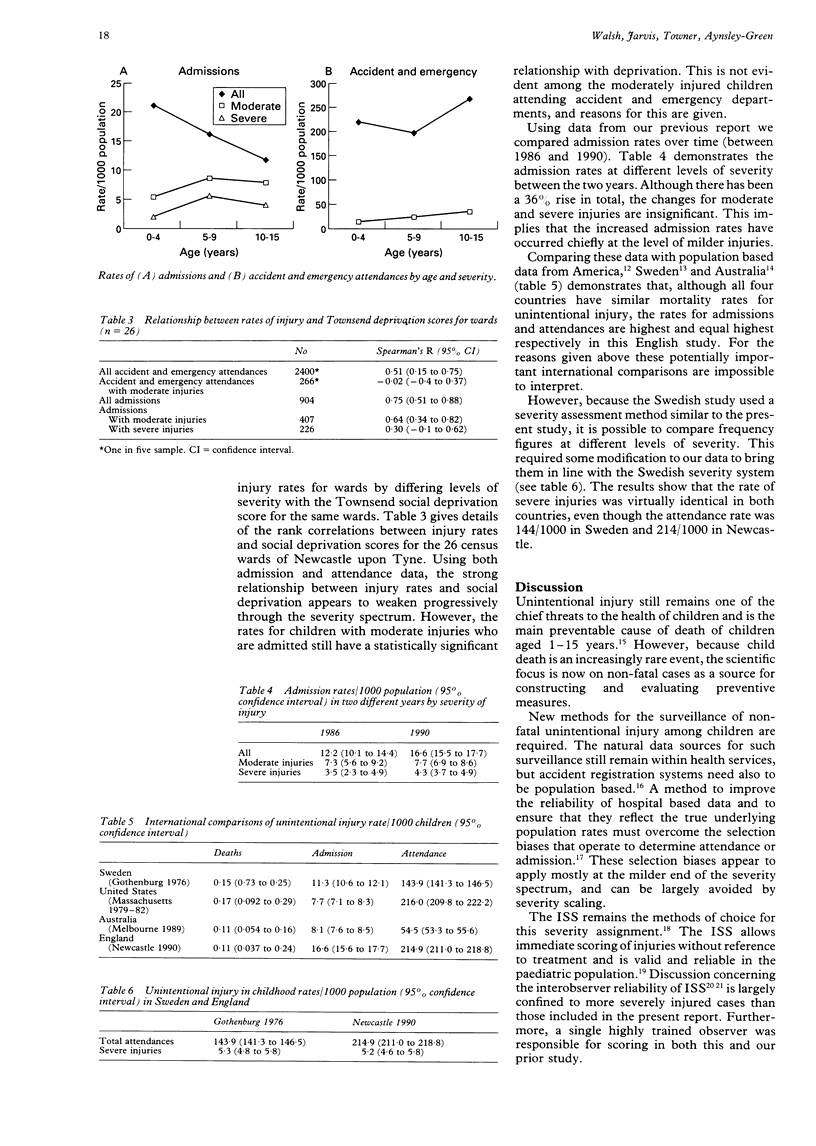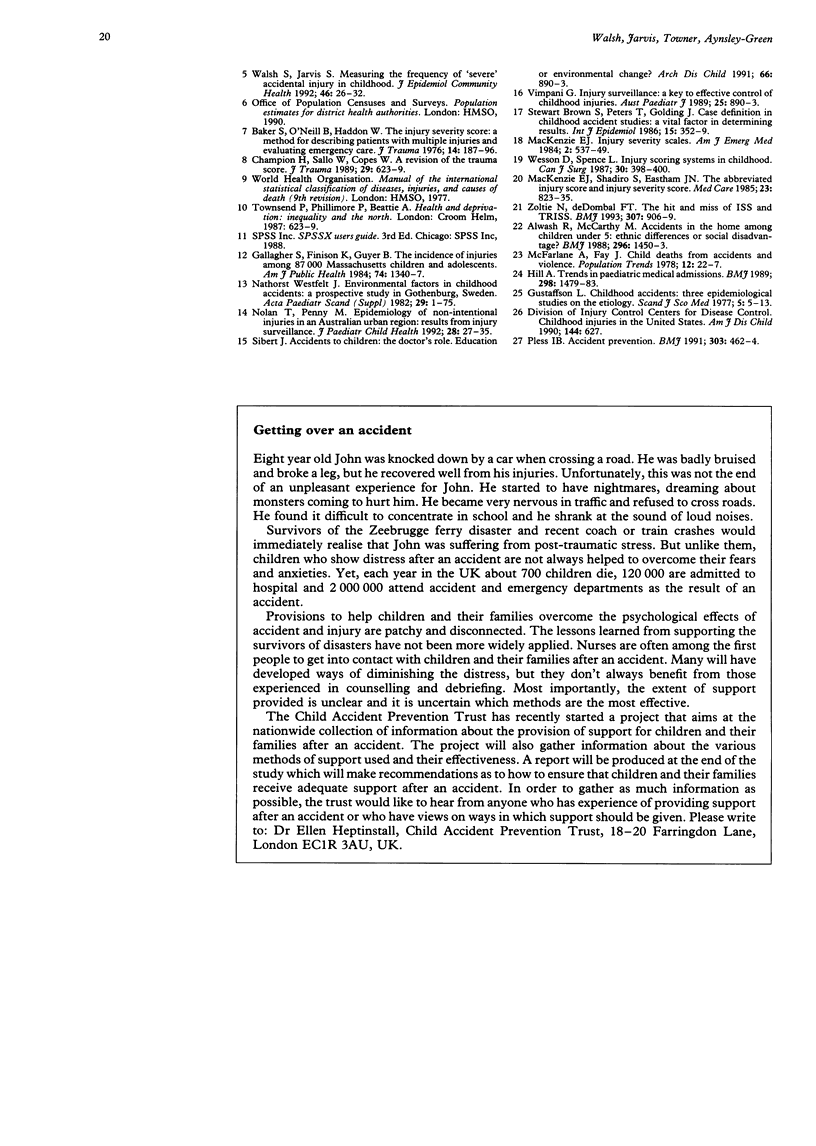Abstract
OBJECTIVE: To enhance the case definition of unintentional injuries in childhood by applying an objective severity measure to fatal and non-fatal cases. DESIGN: A descriptive prospective epidemiological study of a defined resident childhood population (< 16 years of age) for a one year period, 1990. SETTING: Newcastle upon Tyne, England. Child population estimate for 1990 was 54,400. SUBJECTS: Resident children who died, were admitted to local hospitals, or attended local accident and emergency departments. OUTCOME MEASURES: Using recognised severity scoring systems (for example the injury severity score, trauma score) injuries were classified as severe, moderate, or mild. RESULTS: There were six deaths, 904 admissions, and 11,682 accident and emergency department attendances. All deaths, 25% of admissions, and 1% of accident and emergency attenders were classified as severe. The underlying determinants of severe injuries are different than those for all other injuries (for example age, social class). A comparison with a local survey in 1986 showed a 26% rise in hospital admissions, but no significant rise in the frequency of severe or moderately injured children. Comparisons with other international data showed higher rates of injury admissions and attendances for England, but no significant differences in the frequency of severe injuries. CONCLUSIONS: Objective severity scoring enhances the case definition of unintentional injuries in childhood by allowing for the identification, and, therefore, the more reliable ascertainment of severely injured children. This more completely ascertained set of population cases increases the accuracy of comparisons of injury frequency over time and by place, and, in addition, enhances our basic understanding about the epidemiological characteristics of childhood unintentional injury.
Full text
PDF




Selected References
These references are in PubMed. This may not be the complete list of references from this article.
- Alwash R., McCarthy M. Accidents in the home among children under 5: ethnic differences or social disadvantage? Br Med J (Clin Res Ed) 1988 May 21;296(6634):1450–1453. doi: 10.1136/bmj.296.6634.1450. [DOI] [PMC free article] [PubMed] [Google Scholar]
- Baker S. P., O'Neill B., Haddon W., Jr, Long W. B. The injury severity score: a method for describing patients with multiple injuries and evaluating emergency care. J Trauma. 1974 Mar;14(3):187–196. [PubMed] [Google Scholar]
- Champion H. R., Sacco W. J., Copes W. S., Gann D. S., Gennarelli T. A., Flanagan M. E. A revision of the Trauma Score. J Trauma. 1989 May;29(5):623–629. doi: 10.1097/00005373-198905000-00017. [DOI] [PubMed] [Google Scholar]
- Gallagher S. S., Finison K., Guyer B., Goodenough S. The incidence of injuries among 87,000 Massachusetts children and adolescents: results of the 1980-81 Statewide Childhood Injury Prevention Program Surveillance System. Am J Public Health. 1984 Dec;74(12):1340–1347. doi: 10.2105/ajph.74.12.1340. [DOI] [PMC free article] [PubMed] [Google Scholar]
- Gratz R. R. Accidental injury in childhood: a literature review on pediatric trauma. J Trauma. 1979 Aug;19(8):551–555. [PubMed] [Google Scholar]
- Hill A. M. Trends in paediatric medical admissions. BMJ. 1989 Jun 3;298(6686):1479–1483. doi: 10.1136/bmj.298.6686.1479. [DOI] [PMC free article] [PubMed] [Google Scholar]
- MacKenzie E. J. Injury severity scales: overview and directions for future research. Am J Emerg Med. 1984 Nov;2(6):537–549. doi: 10.1016/0735-6757(84)90081-0. [DOI] [PubMed] [Google Scholar]
- MacKenzie E. J., Shapiro S., Eastham J. N. The Abbreviated Injury Scale and Injury Severity Score. Levels of inter- and intrarater reliability. Med Care. 1985 Jun;23(6):823–835. doi: 10.1097/00005650-198506000-00008. [DOI] [PubMed] [Google Scholar]
- Nathorst Westfelt J. A. Environmental factors in childhood accidents. A prospective study in Göteborg, Sweden. Acta Paediatr Scand Suppl. 1982;291:1–75. [PubMed] [Google Scholar]
- Nolan T., Penny M. Epidemiology of non-intentional injuries in an Australian urban region: results from injury surveillance. J Paediatr Child Health. 1992 Feb;28(1):27–35. doi: 10.1111/j.1440-1754.1992.tb02613.x. [DOI] [PubMed] [Google Scholar]
- Pless I. B. Accident prevention. BMJ. 1991 Aug 24;303(6800):462–464. doi: 10.1136/bmj.303.6800.462. [DOI] [PMC free article] [PubMed] [Google Scholar]
- Rivara F. P. Epidemiology of childhood injuries. I. review of current research and presentation of conceptual framework. Am J Dis Child. 1982 May;136(5):399–405. [PubMed] [Google Scholar]
- Sibert J. R. Accidents to children: the doctor's role. Education or environmental change? Arch Dis Child. 1991 Jul;66(7):890–893. doi: 10.1136/adc.66.7.890. [DOI] [PMC free article] [PubMed] [Google Scholar]
- Stewart-Brown S., Peters T. J., Golding J., Bijur P. Case definition in childhood accident studies: a vital factor in determining results. Int J Epidemiol. 1986 Sep;15(3):352–359. doi: 10.1093/ije/15.3.352. [DOI] [PubMed] [Google Scholar]
- Taket A. Accident mortality in children, adolescents and young adults. World Health Stat Q. 1986;39(3):232–256. [PubMed] [Google Scholar]
- Walsh S. S., Jarvis S. N. Measuring the frequency of "severe" accidental injury in childhood. J Epidemiol Community Health. 1992 Feb;46(1):26–32. doi: 10.1136/jech.46.1.26. [DOI] [PMC free article] [PubMed] [Google Scholar]
- Wesson D. E., Spence L. J., Williams J. I., Armstrong P. F. Injury scoring systems in children. Can J Surg. 1987 Nov;30(6):398–400. [PubMed] [Google Scholar]
- Zoltie N., de Dombal F. T. The hit and miss of ISS and TRISS. Yorkshire Trauma Audit Group. BMJ. 1993 Oct 9;307(6909):906–909. doi: 10.1136/bmj.307.6909.906. [DOI] [PMC free article] [PubMed] [Google Scholar]


